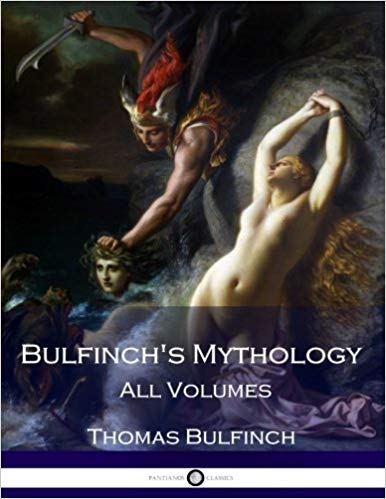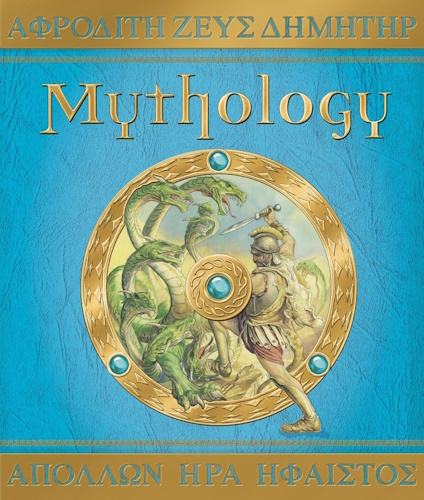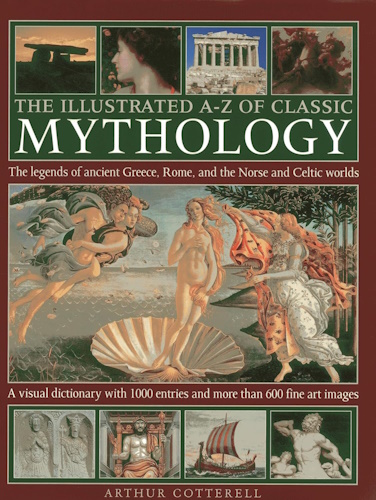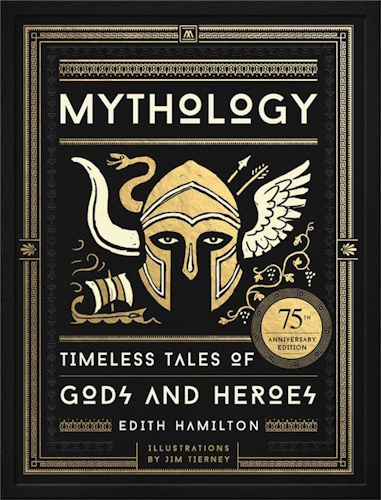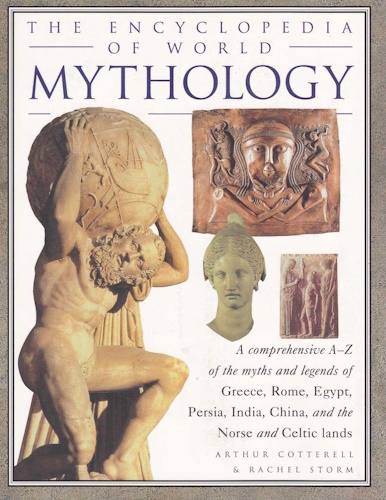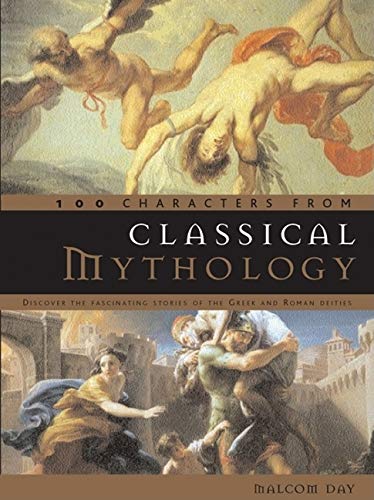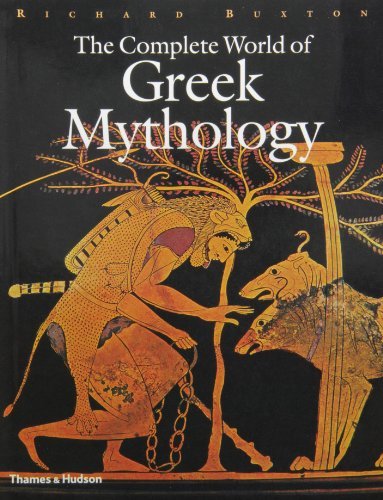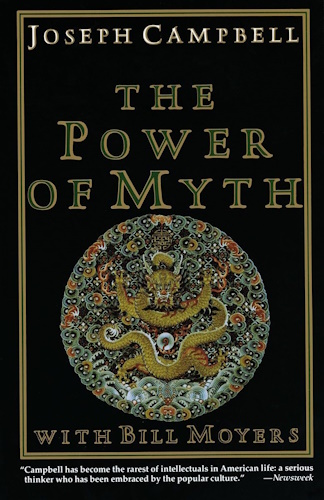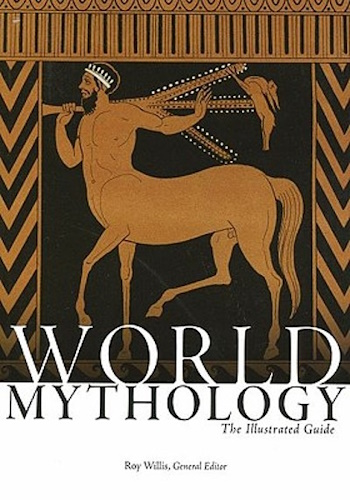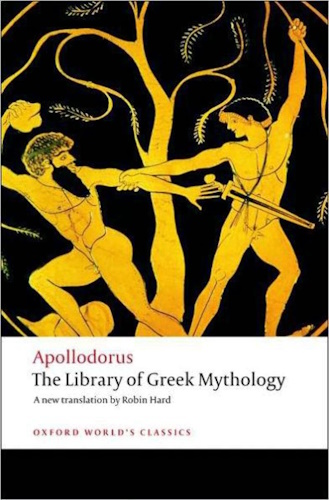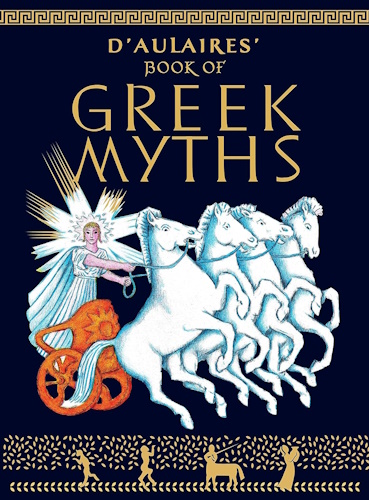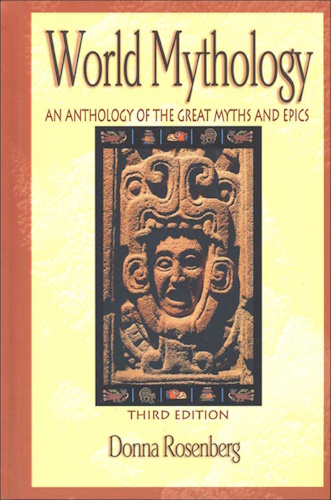
![]()
![]()
CHAPTER XIV.
MINERVA- NIOBE.
MINERVA.
MINERVA, the goddess of wisdom, was the daughter of Jupiter. She was said to have leaped forth from his brain, mature, and in complete armour. She presided over the useful and ornamental arts, both those of men- such as agriculture and navigation- and those of women,- spinning, weaving, and needlework. She was also a warlike divinity; but it was defensive war only that she patronized, and she had no sympathy with Mars's savage love of violence and bloodshed. Athens was her chosen seat, her own city, awarded to her as the prize of a contest with Neptune, who also aspired to it, The tale ran that in the reign of Cecrops, the first king of Athens, the two deities contended for the possession of the city. The gods decreed that it should be awarded to that one who produced the gift most useful to mortals. Neptune gave the horse; Minerva produced the olive. The gods gave judgment that the olive was the more useful of the two, and awarded the city to the goddess; and it was named after her, Athens, her name in Greek being Athene.
There was another contest, in which a mortal dared to come in competition with Minerva. That mortal was Arachne, a maiden who had attained such skill in the arts of weaving and embroidery that the nymphs themselves would leave their groves and fountains to come and gaze upon her work. It was not only beautiful when it was done, but beautiful also in the doing. To watch her, as she took the wool in its rude state and formed it into rolls, or separated it with her fingers and carded it till it looked as light and soft as a cloud, or twirled the spindle with skilful touch, or wove the web, or, after it was woven, adorned it with her needle, one would have said that Minerva herself had taught her. But this she denied, and could not bear to be thought a pupil even of a goddess. "Let Minerva try her skill with mine," said she; "if beaten I will pay the penalty." Minerva heard this and was displeased. She assumed the form of an old woman and went and gave Arachne some friendly advice. "I have had much experience," said she, "and I hope you will not despise my counsel. Challenge your fellow-mortals as you will, but do not compete with a goddess. On the contrary, I advise you to ask her forgiveness for what you have said, and as she is merciful perhaps she will pardon you." Arachne stopped her spinning and looked at the old dame with anger in her countenance. "Keep your counsel," said she, "for your daughters or handmaids; for my part I know what I say, and I stand to it. I am not afraid of the goddess; let her try her skill, if she dare venture." "She comes," said Minerva; and dropping her disguise stood confessed. The nymphs bent low in homage, and all the bystanders paid reverence. Arachne alone was unterrified. She blushed, indeed; a sudden colour dyed her cheek, and then she grew pale. But she stood to her resolve, and with a foolish conceit of her own skill rushed on her fate. Minerva forbore no longer nor interposed any further advice. They proceed to the contest. Each takes her station and attaches the web to the beam. Then the slender shuttle is passed in and out among the threads. The reed with its fine teeth strikes the woof into its place and compacts the web. Both work with speed; their skilful hands move rapidly, and the excitement of the contest makes the labour light. Wool of Tyrian dye is contrasted with that of other colours, shaded off into one another so adroitly that the joining deceives the eye. Like the bow, whose long arch tinges the heavens, formed by sunbeams reflected from the shower,* in which, where the colours meet they seem as one, but a little distance from the point of contact are wholly different.
* This correct description of the rainbow is literally translated from Ovid.
Minerva wrought on her web the scene of her contest with Neptune. Twelve of the heavenly powers are represented, Jupiter, with august gravity, sitting in the midst. Neptune, the ruler of the sea, holds his trident, and appears to have just smitten the earth, from which a horse has leaped forth. Minerva depicted herself with helmed head, her AEgis covering her breast. Such was the central circle; and in the four corners were represented incidents illustrating the displeasure of the gods at such presumptuous mortals as had dared to contend with them. These were meant as warnings to her rival to give up the contest before it was too late.
Arachne filled her web with subjects designedly chosen to exhibit the failings and errors of the gods. One scene represented Leda caressing the swan, under which form Jupiter had disguised himself; and another, Danae, in the brazen tower in which her father had imprisoned her, but where the god effected his entrance in the form of a golden shower. Still another depicted Europa deceived by Jupiter under the disguise of a bull. Encouraged by the tameness of the animal Europa ventured to mount his back, whereupon Jupiter advanced into the sea and swam with her to Crete, You would have thought it was a real bull, so naturally was it wrought, and so natural the water in which it swam. She seemed to look with longing eyes back upon the shore she was leaving, and to call to her companions for help. She appeared to shudder with terror at the sight of the heaving waves, and to draw back her feel, from the water.
Arachne filled her canvas with similar subjects, wonderfully well done, but strongly marking her presumption and impiety. Minerva could not forbear to admire, yet felt indignant at the insult. She struck the web with her shuttle and rent it in pieces; she then touched the forehead of Arachne and made her feel her guilt and shame. She could not endure it and went and hanged herself. Minerva pitied her as she saw her suspended by a rope. "Live," she said, "guilty woman! and that you may preserve the memory of this lesson, continue to hang, both you and your descendants, to all future times." She sprinkled her with the juices of aconite, and immediately her hair came off, and her nose and ears likewise. Her form shrank up, and her head grew smaller yet; her fingers cleaved to her side and served for legs. All the rest of her is body, out of which she spins her thread, often hanging suspended by it, in the same attitude as when Minerva touched her and transformed her into a spider.
Spenser tells the story of Arachne in his "Muiopotmos," adhering very closely to his master Ovid, but improving upon him in the conclusion of the story. The two stanzas which follow tell what was done after the goddess had depicted her creation of the olive tree:
"Amongst these leaves she made a Butterfly,With excellent device and wondrous slight,
Fluttering among the olives wantonly,
That seemed to live, so like it was in sight;
The velvet nap which on his wings doth lie,
The silken down with which his back is dight,
His broad outstretched horns, his hairy thighs,
His glorious colours, and his glistening eyes."*
"Which when Arachne saw, as overlaid
And mastered with workmanship so rare,
She stood astonied long, ne aught gainsaid;
And with fast-fixed eyes on her did stare,
And by her silence, sign of one dismayed,
The victory did yield her as her share:
Yet did she inly fret and felly burn,
And all her blood to poisonous rancour turn."
* Sir James Mackintosh says of this, "Do you think that even a Chinese could paint the gay colours of a butterfly with more minute exactness than the following lines: 'The velvet nap,' etc.?"- Life, Vol. II. 246.
And so the metamorphosis is caused by Arachne's own mortification and vexation, and not by any direct act of the goddess.
The following specimen of old-fashioned gallantry is by Garrick:
"UPON A LADY'S EMBROIDERY"Arachne once, as poets tell,
A goddess at her art defied,
And soon the daring mortal fell
The hapless victim of her pride.
"O, then beware Arachne's fate;
Be prudent, Chloe, and submit,
For you'll most surely meet her hate,
Who rival both her art and wit."
Tennyson, in his "Palace of Art," describing the works of art with which the palace was adorned, thus alludes to Europa:
"...sweet Europa's mantle blew unclaspedFrom off her shoulder, backward borne,
From one hand drooped a crocus, one hand grasped
The mild bull's golden horn."
In his "Princess" there is this allusion to Danae:
"Now lies the earth all Danae to the stars,And all thy heart lies open unto me."
NIOBE.
The fate of Arachne was noised abroad through all the country, and served as a warning to all presumptuous mortals not to compare themselves with the divinities. But one, and she a matron too, failed to learn the lesson of humility. It was Niobe, the queen of Thebes. She had indeed much to be proud of; but it was not her husband's fame, nor her own beauty, nor their great descent, nor the power of their kingdom that elated her. It was her children; and truly the happiest of mothers would Niobe have been if only she had not claimed to be so. It was on occasion of the annual celebration in honour of Latona and her offspring, Apollo and Diana,- when the people of Thebes were assembled, their brows crowned with laurel, bearing frankincense to the altars and paying their vows,- that Niobe appeared among the crowd. Her attire was splendid with gold and gems, and her aspect beautiful as the face of an angry woman can be. She stood and surveyed the people with haughty looks. "What folly," said she, "is this!- to prefer beings whom you never saw to those who stand before your eyes! Why should Latona be honoured with worship, and none be paid to me? My father was Tantalus, who was received as a guest at the table of the gods; my mother was a goddess. My husband built and rules this city, Thebes, and Phrygia is my paternal inheritance. Wherever I turn my eyes I survey the elements of my power; nor is my form and presence unworthy of a goddess. To all this let me add I have seven sons and seven daughters, and look for sons-in-law and daughters-in-law of pretensions worthy of my alliance. Have I not cause for pride? Will you prefer to me this Latona, the Titan's daughter, with her two children? I have seven times as many. Fortunate indeed am I, and fortunate I shall remain! Will any one deny this? My abundance is my security. I feel myself too strong for Fortune to subdue. She may take from me much; I shall still have much left. Were I to lose some of my children, I should hardly be left as poor as Latona with her two only. Away with you from these solemnities,- put off the laurel from your brows,- have done with this worship!" The people obeyed, and left the sacred services uncompleted.
The goddess was indignant. On the Cynthian mountain top where she dwelt she thus addressed her son and daughter: "My children, I who have been so proud of you both, and have been used to hold myself second to none of the goddesses except Juno alone, begin now to doubt whether I am indeed a goddess. I shall be deprived of my worship altogether unless you protect me." She was proceeding in this strain, but Apollo interrupted her. "Say no more," said he; "speech only delays punishment." So said Diana also. Darting through the air, veiled in clouds, they alighted on the towers of the city. Spread out before the gates was a broad plain, where the youth of the city pursued their warlike sports. The sons of Niobe were there with the rest,- some mounted on spirited horses richly caparisoned, some driving gay chariots, Ismenos, the first-born, as he guided his foaming steeds, struck with an arrow from above, cried out, "Ah me!" dropped the reins, and fell lifeless. Another, hearing the sound of the bow,- like the boatman who sees the storm gathering and makes all sail for the port,- gave the reins to his horses and attempted to escape. The inevitable arrow overtook him, as he fled. Two others, younger boys, just from their tasks, had gone to the playground to have a game of wrestling. As they stood breast to breast, one arrow pierced them both. They uttered a cry together, together cast a parting look around them, and together breathed their last. Alphenor, an elder brother, seeing them fall, hastened to the spot to render assistance, and fell stricken in the act of brotherly duty. One only was left, Ilioneus. He raised his arms to heaven to try whether prayer might not avail. "Spare me, ye gods!" he cried, addressing all, in his ignorance that all needed not his intercessions; and Apollo would have spared him, but the arrow had already left the string, and it was too late.
The terror of the people and grief of the attendants soon made Niobe acquainted with what had taken place. She could hardly think it possible; she was indignant that the gods had dared, and amazed that they had been able to do it. Her husband, Amphion, overwhelmed with the blow, destroyed himself. Alas! how different was this Niobe from her who had so lately driven away the people from the sacred rites, and held her stately course through the city, the envy of her friends, now the pity even of her foes! She knelt over the lifeless bodies, and kissed now one, now another of her dead sons. Raising her pallid arms to heaven, "Cruel Latona," said she, "feed full your rage with my anguish! Satiate your hard heart, while I follow to the grave my seven sons. Yet where is your triumph? Bereaved as I am, I am still richer than you, my conqueror." Scarce had she spoken, when the bow sounded and struck terror into all hearts except Niobe's alone. She was brave from excess of grief, The sisters stood in garments of mourning over the biers of their dead brothers. One fell, struck by an arrow, and died on the corpse she was bewailing. Another, attempting to console her mother, suddenly ceased to speak, and sank lifeless to the earth. A third tried to escape by flight, a fourth by concealment, another stood trembling, uncertain what course to take. Six were now dead, and only one remained, whom the mother held clasped in her arms, and covered as it were with her whole body. "Spare me one, and that the youngest! O spare me one of so many!" she cried; and while she spoke, that one fell dead. Desolate she sat, among sons, daughters, husband, all dead, and seemed torpid with grief. The breeze moved not her hair, no colour was on her cheek, her eyes glared fixed and immovable, there was no sign of life about her. Her very tongue cleaved to the roof of her mouth, and her veins ceased to convey the tide of life. Her neck bent not, her arms made no gesture, her foot no step. She was changed to stone, within and without. Yet tears continued to flow; and borne on a whirlwind to her native mountain, she still remains, a mass of rock, from which a trickling stream flows, the tribute of her never-ending grief.
The story of Niobe has furnished Byron with a fine illustration of the fallen condition of modern Rome:
"The Niobe of nations! there she stands,Childless and crownless in her voiceless woe;
An empty urn within her withered hands,
Whose holy dust was scattered long ago;
The Scipios' tomb contains no ashes now:
The very sepulchres lie tenantless
Of their heroic dwellers; dost thou flow,
Old Tiber! through a marble wilderness?
Rise with thy yellow waves, and mantle her distress."
Childe Harold, IV. 79.
As an illustration of this story there is a celebrated statue in the imperial gallery of Florence. It is the principal figure of a group supposed to have been originally arranged in the pediment of a temple. The figure of the mother clasped by the arm of her terrified child is one of the most admired of the ancient statues. It ranks with the Laocoon and the Apollo among the masterpieces of art. The following is a translation of a Greek epigram supposed to relate to this statue:
"To stone the gods have changed her, but in vain;The sculptor's art has made her breathe again."
Tragic as is the Story of Niobe, we cannot forbear to smile at the use Moore has made of it in "Rhymes on the Road":
"'Twas in his carriage the sublimeSir Richard Blackmore used to rhyme,
And, if the wits don't do him wrong,
'Twixt death and epics passed his time,
Scribbling and killing all day long;
Like Phoebus in his car at ease,
Now warbling forth a lofty song,
Now murdering the young Niobes."
Sir Richard Blackmore was a physician, and at same time a very prolific and very tasteless poet, whose works are now forgotten, unless when recalled to mind by some wit like Moore for the sake of a joke.
-
Urantia Book, 44:0.11 - The Celestial Artisans
Never in your long ascendancy will you lose the power to recognize your associates of former existences. Always, as you ascend inward in the scale of life, will you retain the ability to recognize and fraternize with the fellow beings of your previous and lower levels of experience. Each new translation or resurrection will add one more group of spirit beings to your vision range without in the least depriving you of the ability to recognize your friends and fellows of former estates.
-
Princess Bride 1987 Wallace Shawn (Vizzini) and Mandy Patinkin (Inigo Montoya)
Vizzini: HE DIDN'T FALL? INCONCEIVABLE.
Inigo Montoya: You keep using that word. I do not think it means what you think it means. -
Urantia Book, 117:4.14 - The Finite God
And here is mystery: The more closely man approaches God through love, the greater the reality -- actuality -- of that man. The more man withdraws from God, the more nearly he approaches nonreality -- cessation of existence. When man consecrates his will to the doing of the Father's will, when man gives God all that he has, then does God make that man more than he is.
-
Urantia Book, 167:7.4 - The Talk About Angels
"And do you not remember that I said to you once before that, if you had your spiritual eyes anointed, you would then see the heavens opened and behold the angels of God ascending and descending? It is by the ministry of the angels that one world may be kept in touch with other worlds, for have I not repeatedly told you that I have other sheep not of this fold?"
-
Urantia Book, Foreword - 0:12.12 - The Trinities
But we know that there dwells within the human mind a fragment of God, and that there sojourns with the human soul the Spirit of Truth; and we further know that these spirit forces conspire to enable material man to grasp the reality of spiritual values and to comprehend the philosophy of universe meanings. But even more certainly we know that these spirits of the Divine Presence are able to assist man in the spiritual appropriation of all truth contributory to the enhancement of the ever-progressing reality of personal religious experience—God-consciousness.
-
Urantia Book, 1:4.3 - The Mystery Of God
When you are through down here, when your course has been run in temporary form on earth, when your trial trip in the flesh is finished, when the dust that composes the mortal tabernacle "returns to the earth whence it came"; then, it is revealed, the indwelling "Spirit shall return to God who gave it." There sojourns within each moral being of this planet a fragment of God, a part and parcel of divinity. It is not yet yours by right of possession, but it is designedly intended to be one with you if you survive the mortal existence.
-
Urantia Book, 1:4.1 - The Mystery Of God
And the greatest of all the unfathomable mysteries of God is the phenomenon of the divine indwelling of mortal minds. The manner in which the Universal Father sojourns with the creatures of time is the most profound of all universe mysteries; the divine presence in the mind of man is the mystery of mysteries.
-
Urantia Book, 1:4.6 - The Mystery Of God
To every spirit being and to every mortal creature in every sphere and on every world of the universe of universes, the Universal Father reveals all of his gracious and divine self that can be discerned or comprehended by such spirit beings and by such mortal creatures. God is no respecter of persons, either spiritual or material. The divine presence which any child of the universe enjoys at any given moment is limited only by the capacity of such a creature to receive and to discern the spirit actualities of the supermaterial world.
-
Urantia Book, 11:0.1 - The Eternal Isle Of Paradise
Paradise is the eternal center of the universe of universes and the abiding place of the Universal Father, the Eternal Son, the Infinite Spirit, and their divine co-ordinates and associates. This central Isle is the most gigantic organized body of cosmic reality in all the master universe. Paradise is a material sphere as well as a spiritual abode. All of the intelligent creation of the Universal Father is domiciled on material abodes; hence must the absolute controlling center also be material, literal. And again it should be reiterated that spirit things and spiritual beings are real.
-
Urantia Book, 50:6.4 - Planetary Culture
Culture presupposes quality of mind; culture cannot be enhanced unless mind is elevated. Superior intellect will seek a noble culture and find some way to attain such a goal. Inferior minds will spurn the highest culture even when presented to them ready-made.
-
Urantia Book, 54:1.6 - True And False Liberty
True liberty is the associate of genuine self-respect; false liberty is the consort of self-admiration. True liberty is the fruit of self-control; false liberty, the assumption of self-assertion. Self-control leads to altruistic service; self-admiration tends towards the exploitation of others for the selfish aggrandizement of such a mistaken individual as is willing to sacrifice righteous attainment for the sake of possessing unjust power over his fellow beings.
-
Urantia Book, 54:1.9 - True And False Liberty
How dare the self-willed creature encroach upon the rights of his fellows in the name of personal liberty when the Supreme Rulers of the universe stand back in merciful respect for these prerogatives of will and potentials of personality! No being, in the exercise of his supposed personal liberty, has a right to deprive any other being of those privileges of existence conferred by the Creators and duly respected by all their loyal associates, subordinates, and subjects.
-
Urantia Book, 54:1.8 - True And False Liberty
There is no error greater than that species of self-deception which leads intelligent beings to crave the exercise of power over other beings for the purpose of depriving these persons of their natural liberties. The golden rule of human fairness cries out against all such fraud, unfairness, selfishness, and unrighteousness.
